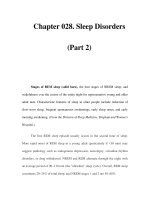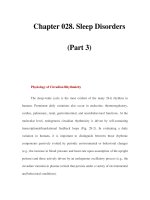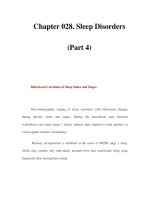Marcro micro econmiy david begg chapter 028
Bạn đang xem bản rút gọn của tài liệu. Xem và tải ngay bản đầy đủ của tài liệu tại đây (137.3 KB, 22 trang )
Chapter 28
Inflation
David Begg, Stanley Fischer and Rudiger Dornbusch, Economics,
6th Edition, McGraw-Hill, 2000
Power Point presentation by Peter Smith
Inflation is ...
Inflation is a rise in the average price
of goods over time
One of the first acts of the Labour
government in 1997 was to make the
Bank of England independent
–
with a mandate to achieve low inflation.
28.2
Some questions about inflation
Why is inflation bad?
–
Inflation does have bad effects, but
some popular criticisms are based on
spurious reasoning
What are the causes of inflation?
What can be done about it?
28.3
Inflation in the UK, 1950-99
30
25
15
10
5
19
90
19
70
0
19
50
% p.a.
20
Source: Economic Trends Annual Supplement, Labour Market Trends
28.4
The quantity theory of money
The quantity theory of money says
that changes in the nominal money
supply lead to equivalent changes in
the price level (and money wages)
but do not have effects on output
and employment.
28.5
The quantity theory (2)
The quantity theory of money says:
MV=PY
–
where V = velocity of circulation
If prices adjust to maintain real income (Y)
at the potential level and if velocity stays
constant
then an increase in nominal money supply
leads to an equivalent increase in prices
but if velocity is variable or prices are
sluggish, this link is broken.
28.6
Money and prices
Milton Friedman famously claimed
‘Inflation is always and everywhere a
monetary phenomenon.’
–
i.e. it results when money supply grows more
rapidly than real output.
But this does not prove that causation is
always from money to prices
–
e.g. if the government adopts an
accommodating monetary policy.
28.7
Money and inflation (2)
…but in the long run, changes in real
income and interest rates significantly
alter real money demand
so there may not be a perfect
correspondence between excess
monetary growth and inflation.
And in the short run, the link between
money and prices may be broken if
–
–
velocity of circulation is variable
prices are sluggish
28.8
Inflation and interest rates
FISHER HYPOTHESIS
–
a 1% increase in inflation will be accompanied
by a 1% increase in interest rates
REAL INTEREST RATE
–
–
–
–
Nominal interest rate – inflation rate
i.e. the Fisher hypothesis says that real
interest rates do not change much
but the nominal interest rate is the opportunity
cost of holding money
so a change in nominal interest rates affects
real money demand
28.9
Hyperinflation
… periods when inflation rates are very
large
in such periods there tends to be a ‘flight
from money’
–
people hold as little money as possible
e.g. Germany in 1922-23, Hungary 1945-46, Brazil in
the late 1980s.
Large government budget deficits help to
explain such periods
–
persistent inflation must be accompanied by
continuing money growth
28.10
The Phillips curve
The Phillips curve shows
that a higher inflation rate
is accompanied by a
lower unemployment rate.
Inflation rate (%)
Prof. A W Phillips demonstrated a statistical relationship
between annual inflation and unemployment in the UK
Phillips curve
It suggests we can
trade-off more inflation for
less unemployment or
vice versa.
Unemployment rate (%)
28.11
The Phillips curve and an increase
in aggregate demand
Inflation
Suppose the economy
begins at E, with zero
inflation, unemployment
at the natural rate U*...
π1
An increase in government
spending funded by an
expansion in money supply
takes the economy to A,
with lower unemployment
but inflation at π 1.
A
U1
PC0 … but what happens
Unemployment
next?
28.12
U*
The Phillips curve and an increase
in aggregate demand
Inflation
If nominal money supply
is fixed in the long run,
and prices and wages
eventually adjust, the
economy moves back to E.
But nominal money supply
need not be constant in the
long run
π1
A
C
E
U1
U*
Unemployment
PC0
so we may find the
economy finds its way
back to the natural rate,
but with continuing
inflation at C.
28.13
The vertical Phillips curve
LRPC
Inflation
π1
Effectively, the long-run
Phillips curve is vertical,
as the economy always
adjusts back to U*.
The short-run Phillips curve
shows just a short-run
trade-off –
A
C
E
U1
U*
Unemployment
its position may depend
PC1 upon expectations about
inflation.
PC0
28.14
Expectations and credibility
Inflation
LRPC
E
π1
π2
F
U*
Suppose the economy begins
at E, with a newly-elected
government pledged to
reduce inflation.
Monetary growth is cut to π 2.
In the short run, the economy
moves to A along the shortA
run Phillips curve.
PC1 Unemployment rises to U
1
As expectations adjust,
PC2
the short-run Phillips curve
U1
shifts to PC2, and U*
Unemployment
is restored at F.
28.15
Inflation
Inflation and unemployment
in the UK 1978-99
20
18
16
14
12
10
8
6
4
2
0
1980
1990
1978
1993
1999
4
6
8
10
1986
12
Unemployment
28.16
Inflation illusion
People have inflation illusion when
they confuse nominal and real
changes.
People’s welfare depends upon real
variables, not nominal variables.
If all nominal variables (prices and
incomes) increase at the same rate,
real income does not change.
28.17
The costs of inflation
Fully anticipated inflation:
Institutions adapt to known inflation:
–
–
–
nominal interest rates
tax rates
transfer payments
no inflation illusion
Some costs remain:
–
shoe-leather
people economize on money holdings
–
menu costs
firms need to alter price lists etc.
28.18
The costs of inflation (2)
Even if inflation is fully anticipated,
the economy may not fully adapt
–
–
interest rates may not fully reflect
inflation
taxes may be distorted
fiscal drag may have unintended effects on
tax liabilities
capital and profits taxes may be distorted
28.19
The costs of unanticipated inflation
Unintended redistribution of income
–
–
–
from lenders to borrowers
from private to public sector
from young to old
Uncertainty
–
firms find planning more difficult under
inflation, which may discourage
investment
This has been seen as the most
important cost of inflation
28.20
Defeating inflation
In the long run, inflation will be low if
the rate of money growth is low.
The transition from high to low
inflation may be painful if
expectations are slow to adjust.
Policy credibility may speed the
adjustment process
28.21
The Monetary Policy Committee
Central Bank Independence may improve
the credibility of anti-inflation policy
Since 1997 UK monetary policy has been
set by the Bank of England’s Monetary
Policy Committee
–
which has the responsibility of meeting the
inflation target
–
via interest rates
–
which are set according to inflation forecasts.
28.22









